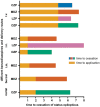Benzodiazepines in the Management of Seizures and Status Epilepticus: A Review of Routes of Delivery, Pharmacokinetics, Efficacy, and Tolerability
- PMID: 35971024
- PMCID: PMC9477921
- DOI: 10.1007/s40263-022-00940-2
Benzodiazepines in the Management of Seizures and Status Epilepticus: A Review of Routes of Delivery, Pharmacokinetics, Efficacy, and Tolerability
Abstract
Status epilepticus (SE) is an acute, life-threatening medical condition that requires immediate, effective therapy. Therefore, the acute care of prolonged seizures and SE is a constant challenge for healthcare professionals, in both the pre-hospital and the in-hospital settings. Benzodiazepines (BZDs) are the first-line treatment for SE worldwide due to their efficacy, tolerability, and rapid onset of action. Although all BZDs act as allosteric modulators at the inhibitory gamma-aminobutyric acid (GABA)A receptor, the individual agents have different efficacy profiles and pharmacokinetic and pharmacodynamic properties, some of which differ significantly. The conventional BZDs clonazepam, diazepam, lorazepam and midazolam differ mainly in their durations of action and available routes of administration. In addition to the common intravenous, intramuscular and rectal administrations that have long been established in the acute treatment of SE, other administration routes for BZDs-such as intranasal administration-have been developed in recent years, with some preparations already commercially available. Most recently, the intrapulmonary administration of BZDs via an inhaler has been investigated. This narrative review provides an overview of the current knowledge on the efficacy and tolerability of different BZDs, with a focus on different routes of administration and therapeutic specificities for different patient groups, and offers an outlook on potential future drug developments for the treatment of prolonged seizures and SE.
© 2022. The Author(s).
Conflict of interest statement
RK, LW, IB, SG, SvB, CM, AL, JHS, KS and LMW declare that they have no conflicts of interest. JPZ reports speakers’ honoraria and travel grants from Eisai and Desitin Arzneimittel. SSB reports personal fees from Eisai, Desitin Pharma, GW Pharmaceuticals companies, LivaNova, UCB, and Zogenix. FR reports grants and personal fees from UCB Pharma, Arvelle Therapeutics, and Desitin Arzneimittel, personal fees from Eisai, GW Pharmaceuticals, Novartis, Medtronic, Cerbomed, Sandoz, BayerVital, and Shire, and grants from the European Union, Deutsche Forschungsgemeinschaft, the LOEWE Programm of the state of Hesse, and the Detlev-Wrobel-Fonds for Epilepsy Research. AS reports personal fees and grants from Angelini Pharma/Arvelle Therapeutics, Desitin Arzneimittel, Eisai, GW Pharmaceuticals, Marinus Pharmaceuticals, UCB Pharma, UNEEG medical, and Zogenix. The authors have no other relevant affiliations or financial involvement with any organization or entity with a financial interest in or financial conflict with the subject matter or materials discussed in this review apart from those disclosed.
Figures



References
-
- Schubert-Bast S, Zollner JP, Ansorge S, Hapfelmeier J, Bonthapally V, Eldar-Lissai A, et al. Burden and epidemiology of status epilepticus in infants, children, and adolescents: a population-based study on German health insurance data. Epilepsia. 2019;60(5):911–920. doi: 10.1111/epi.14729. - DOI - PubMed
Publication types
MeSH terms
Substances
LinkOut - more resources
Full Text Sources
Medical

